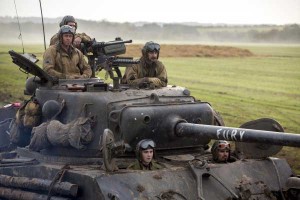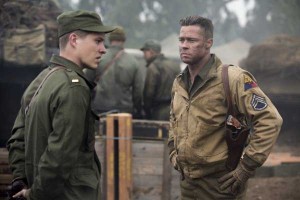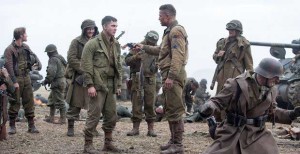
Production designer Andrew Menzies finished working on Fury a year to the day before speaking to BTL. With art department credits on Munich, Syriana, The Chronicles of Riddick, Vanilla Sky, A.I. Artificial Intelligence, Avatar (as art director) and other titles covering almost any real-world or fantastical designs that filmmaking could call for, Menzies could hardly be more qualified to tackle a reproduction of the campaign that finished World War II in Europe.
It is, he says, a film deeply concerned with accuracy and realism. “It’s not about aesthetic design. David Ayer [director] was determined that everything be authentic, down to the pocketknives, down to their handkerchiefs. He wouldn’t accept even reproductions, we had to get the real thing.” Relying on eBay and other sources to obtain specimen items, now antiques in their own right, the filmmakers fabricated huge quantities of uniforms and props to match them. “David’s forte is German uniforms and memorabilia. He’s an expert in that field.”

Despite these lofty ideals, preproduction on Ayer’s production – budgeted at $66 million, which might be considered relatively modest given the scale of the piece – lasted the usual three months. “It was absolutely full on,” said Menzies. “I’ve probably not worked harder in my life. Every weekend, every moment I spent researching. I was determined to make it as authentic as possible and that only comes from research.” Discovering reliable sources, he admitted, was not always easy. “Everyone has a bit of knowledge about World War II, but every avenue you go down has an expert, whether it’s the bags or uniforms or firearms. There’s a lot of people who say they know it. You have to find the people who know their stuff, get them on board and pick their brains.”
It is impossible, of course, to overlook the film’s key vehicles. “My first job was to track down the tanks,” recalled Menzies. “There’s not that many in working order now.” The filmmakers’ first port of call was The Tank Museum in Dorset, England, where “it quickly became clear that they were very interested in us using their tanks. They had the Sherman, and then they had the Tiger.” The Tiger, captured more or less intact in Tunisia by the 48th Royal Tank Regiment in 1943, is the only operating example in the world, and the museum staff were understandably cautious about allowing it to be used by the filmmakers. “It hadn’t left the museum in 40 years,” said Menzies. “It’s priceless, literally. It was very hard to pull off, but once they’d seen how we used their Sherman, they lightened up about the Tiger, which was a big coup.” Fury would be the first time a real Tiger has appeared in film since 1946.
 Filming with antique vehicles presented special problems, since at 70 or 80 years of age, even tanks can become geriatric. Heavy engineering was required. “We had to build a concrete track just under the dirt, so the tank had traction and wouldn’t be strained by the mud,” Menzies explained. “Nobody had taken it into a field since it had left the real battlefield. They were concerned that churning up the mud would put strain on it.” Even the titular Sherman could not be used for every shot. “We had to build a replica. We couldn’t use a real tank the whole time. It wasn’t reliable. We made a Fury on a modern tank base, based on a mould from the real one, so every dent, every scratch and every rivet was there.” Even with all this care, limitations remained. “The tanks really designed the movie. They’re 80 years old, they couldn’t do the things they could back then. The ditches and steep hills I’d chosen weren’t appropriate because it risked breaking the tanks.”
Filming with antique vehicles presented special problems, since at 70 or 80 years of age, even tanks can become geriatric. Heavy engineering was required. “We had to build a concrete track just under the dirt, so the tank had traction and wouldn’t be strained by the mud,” Menzies explained. “Nobody had taken it into a field since it had left the real battlefield. They were concerned that churning up the mud would put strain on it.” Even the titular Sherman could not be used for every shot. “We had to build a replica. We couldn’t use a real tank the whole time. It wasn’t reliable. We made a Fury on a modern tank base, based on a mould from the real one, so every dent, every scratch and every rivet was there.” Even with all this care, limitations remained. “The tanks really designed the movie. They’re 80 years old, they couldn’t do the things they could back then. The ditches and steep hills I’d chosen weren’t appropriate because it risked breaking the tanks.”
Perhaps the filmmakers’ biggest challenge was Fury‘s interior, the notoriously cramped metal cocoon within which the tank’s crew operated. A version 10% larger than reality was made, the maximum expansion the filmmakers felt they could get away with. “There were many versions of tank,” Menzies said. “The Easy 8, which we represented, came out near the end of the war. It was driven by what parts we could find, what we could fabricate.” Perhaps ideally, Menzies described the tank interior set as “intense for the performers and for us, because each panel had to wild away so the camera could get in, the turret also had to move around and the gun had to recoil and release smoke. You had this quite large special effect of the recoil, you didn’t want the tank to shake around because ours was lighter.”
 Of the film’s 64-day schedule, Menzies remembered that “we were always against it. For instance, we delivered the interior probably three days before shoot. You’d like to deliver that three weeks before shoot, so you could rehearse, but we built a styrofoam interior for the actors to rehearse in. The whole movie was like that, it was intense and put a lot of people under a lot of pressure.”
Of the film’s 64-day schedule, Menzies remembered that “we were always against it. For instance, we delivered the interior probably three days before shoot. You’d like to deliver that three weeks before shoot, so you could rehearse, but we built a styrofoam interior for the actors to rehearse in. The whole movie was like that, it was intense and put a lot of people under a lot of pressure.”
This pressure was shared among Menzies’ crew, including art director Peter Russell. “I come up with the concepts and choose the locations,” said Menzies. “But I had an excellent art department. I think the U.K. has some of the best trained people in the world for making movies. When you’re making a movie like that it attracts the best. People want to be a part of it, people cut their rates to do it.”
Menzies’ most recent project is somewhat lighter in tone. “I’m finishing up a movie called Monster Trucks for Paramount. After I’d finished doing Fury and staring at dead bodies and war and destruction for months and months, I wanted to do something a little lighter. I wanted to do something my kid could watch!”





